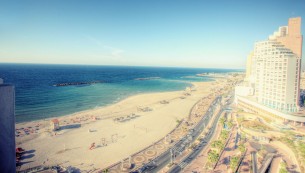Getting Familiar with Israel’s Weather Ahead of Your Upcoming Trip
May 6th 2015
For a small country, Israel is home to a staggeringly diverse climate. On any given day, there could be snow in the Golan, rain in Jerusalem and hot weather in the Negev. Here are some facts about Israel’s weather patterns to help prepare you for your upcoming trip.
Israel’s rainy season generally lasts from around October until April or May. During this winter, the rain can become quite heavy, especially in the north and center of Israel. Strong winds, lightning and thunderstorms are not uncommon, and it may even hail. In the Dead Sea area and the Negev desert, which dominates the southern portion of Israel, rainfall is less of a factor. It almost never rains in Eilat. In the summer months, rain anywhere in Israel is extremely rare.
In general, though, winters are mild and sunny. We recommend packing lots of layers, so you’re prepared for any number of conditions.
 If you’re visiting an area with high elevations, like Jerusalem, Gush Etzion, the Golan or Tzfat, the weather will be cooler than it is in other areas just a few minutes away. Winters in areas of higher elevation are often significantly colder, and snow falls here usually once or twice each winter.
If you’re visiting an area with high elevations, like Jerusalem, Gush Etzion, the Golan or Tzfat, the weather will be cooler than it is in other areas just a few minutes away. Winters in areas of higher elevation are often significantly colder, and snow falls here usually once or twice each winter.
The Mediterranean coastal area is known for its milder winters, though these parts of Israel can become oppressively
humid in the summer, even at night. The Jordan Valley region has moderate winters and extremely hot and dry summer temperatures. In the Negev, you’ll find a desert climate year-round.
The spring and fall seasons are the most comfortable in Israel. It’s no coincidence that this is when the country’s primary holiday seasons take place. This is when the nights are cool and pleasant and the days are predictably warm but not too hot. If you’re traveling here during these transitional seasons, you’re unlikely to need to pack much more than a few long sleeve and short sleeve wardrobe options.
However, during the spring and early summer months, and occasionally during the fall, you might experience a hamsin, a hot wind that blows in from the south or southeast. The extreme heat can raise temperatures significantly in a short period of time. A windless variation on the hamsin, known as a sharav, is often accompanied by dust clouds. Both occur a handful of times each year and can last up to a few days.
During when the conditions get arid, it’s especially important to stay hydrated. Keep out of the sun. If you’re indoors, keep all the windows closed to avoid sand and dust blowing in. It’s best to stay in air-conditioned places like a mall or museum. If you’re traveling, run the air conditioning and never leave children alone in a parked car. Once a hamsin breaks, though, a cool breeze generally comes in and temperatures will drop noticeably.











